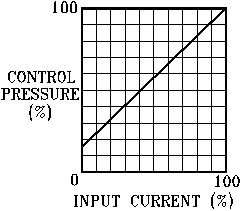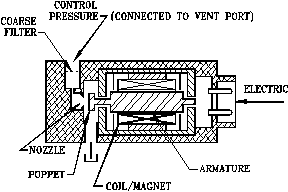

|
|
|
©2000-2002
FEMA Corp.
All Rights Reserved
|
The sectioned view to the right (Figure 2) describes pictorially how a two-way FEMA PPC is configured. As current is increased, the armature / poppet moves toward the nozzle, flow is restricted, and pressure increases at the "Control pressure port". The FEMA PPC is a precision device used to interface two technologies: Hydraulics and Electronics. This presents difficulties in terms of troubleshooting because the problem could be from one or both of these technologies. |
|
|
It is important to use a logical sequence while troubleshooting. Often, the FEMA PPC will merely be replaced to see whether or not the problem is eliminated. Usually, however, the result (sometimes not in the initial hours) is that the new PPC will be damaged. The following guide is designed to help expedite troubleshooting while keeping costs contained. Common IssuesSystem Will Not Build PressureBased on our experience, after having a system problem, we find that the place to start the troubleshooting process is on the electronic side. Measure current at the PPC with a current meter to ensure that the proper electrical signal is being delivered. A separate meter is recommended since often the control system itself gives the wrong indication as to input current that is being applied to the PPC. At this point, if current is not measurable, it might be appropriate to try a second electronic driver. Actually, a simple potentiometer and battery or power supply capable of at least 600 milliamps delivery can easily control a PPC. If pressure can be controlled smoothly and proportionally by the second power source, then the problem is likely in the electronic system (refer to sales drawing of PPC for electrical "current" spec; typically it is 420 to 600 milliamps max). Initially, if current is measurable at the PPC, but there is no pressure output or controllability, the problem is likely hydraulic. "Do not replace the PPC" at this point. First, try reversing the polarity to the PPC as underlined in the following procedure. If this is not successful, we recommend that the PPC tank line be disconnected and the flow be measured. This flow is typically .2 to .4 GPM (check PPC sales drawing). If flow is not adequate, check flow directly from the vent port of the relief valve (between relief valve and PPC). If this flow is per spec, then the PPC is likely plugged by contaminant. If flow from relief valve is not to spec, check with the relief valve manufacturer. If flow is adequate, remove the PPC and replace it with a small manual relief valve (or needle valve if relief valve is not available). The relief valve can be modulated manually, which in turn should control the overall system. If the system can indeed be controlled with the relief valve, then the problem is likely in the PPC. Do not install a new PPC at this point either! The system will first have to be flushed of possible contaminants and cleaned. Do not replace the PPC until both the fluid and the system are cleaned. There are many ways to clean up a contaminated system. Replacing the fluid is one possibility, yet this way may not be feasible. A circulating filtration device is another approach. A third is running and cycling the system (with the manual relief valve installed and set low). This is a good way to flush the lines, especially those that will feed the new PPC. New filter elements should be installed before flushing. This way, the system will "clean itself up". After the system has been flushed and "cleaned up", operate the manual relief valve a few more times to ensure that the system is operating satisfactorily. It is a good idea to replace the system filter elements once again after flushing. At this point, a new PPC can be installed. NOTE: Do not use Teflon tape on the PPC fittings; pipe sealant is, however, acceptable. Also, note that the PPC has a built in filter, either in the manifold port, or if a plumbed unit, in the inlet fitting. Never remove or tamper with this filter. Systems Stays at Partial or Full PressureDisconnect the electronic feed to the PPC. If pressure drops, correct the electronic system. If system stays at full pressure, the PPC may be "clogged". Check flow out the PPC tank port. The next step is to reverse the electrical polarity feeding the PPC (switch wires). Run the system with rated current applied (though reversed) to the PPC. Running a PPC with reversed polarity causes the poppet to open further from the nozzle. This may allow contamination to flush on through the PPC. Switch the polarity back to normal and try running the system. If this is not successful, remove the PPC and replace it with the small manual relief valve as described earlier. Cycle the system and flush the lines as previously discussed. Install the new PPC.
|
Site designed by Steven Shelton for Twilight Media & Design
Updated Sunday, August 18, 2002

